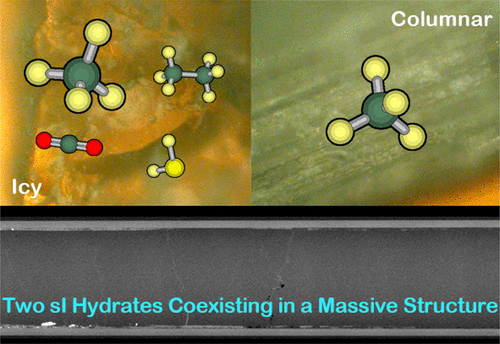当前位置:
X-MOL 学术
›
ACS Earth Space Chem.
›
论文详情
Our official English website, www.x-mol.net, welcomes your feedback! (Note: you will need to create a separate account there.)
Natural Gas Hydrates Recovered from the Umitaka Spur in the Joetsu Basin, Japan: Coexistence of Two Structure-I Hydrates with Distinctly Different Textures and Gas Compositions within a Massive Structure
ACS Earth and Space Chemistry ( IF 3.4 ) Pub Date : 2019-12-11 , DOI: 10.1021/acsearthspacechem.9b00249 Yusuke Jin 1 , Masato Kida 1 , Jun Yoneda 1 , Yoshihiro Konno 1 , Motoi Oshima 1 , Norio Tenma 2 , Jiro Nagao 1
ACS Earth and Space Chemistry ( IF 3.4 ) Pub Date : 2019-12-11 , DOI: 10.1021/acsearthspacechem.9b00249 Yusuke Jin 1 , Masato Kida 1 , Jun Yoneda 1 , Yoshihiro Konno 1 , Motoi Oshima 1 , Norio Tenma 2 , Jiro Nagao 1
Affiliation

|
This study evaluated natural gas hydrates recovered from three different wells (J13R, J07RB, and J23R) at the Umitaka Spur in the Joetsu Basin, via Raman spectroscopy. The hydrates in two of the samples (J13R-13P and J07RB-5P) were of the particle displacement type, whereas sample J23R-3P displayed hydrates of the massive type. The hydrate crystals in all three samples contained a structure-I (sI) hydrate that primarily captures methane (CH4) molecules with ethane (C2H6), carbon dioxide (CO2), and/or hydrogen sulfide (H2S), which were observable using powder X-ray diffraction and Raman spectroscopy techniques. In the massive type J23R-3P sample, two hydrate crystals with different textures were found to coexist, with one displaying an icy appearance and the other a columnar shape. Interestingly, the icy J23R-3P crystals were sI hydrates containing mostly CH4 with C2H6, CO2, and H2S, whereas the columnar J23R-3P crystals were sI CH4 hydrates containing few other guest molecules. The coexistence of two different hydrates was not observed in the nodule type sediment (J13R-13P and J07RB-5P). Isotopic results suggested that the CH4 molecules in the icy and columnar J23R-3P crystals originated from different CH4 sources. Different sI crystals coexisting in the same sample would be because of high CH4 flux, a known feature in the Umitaka Spur.
更新日期:2019-12-11


























 京公网安备 11010802027423号
京公网安备 11010802027423号